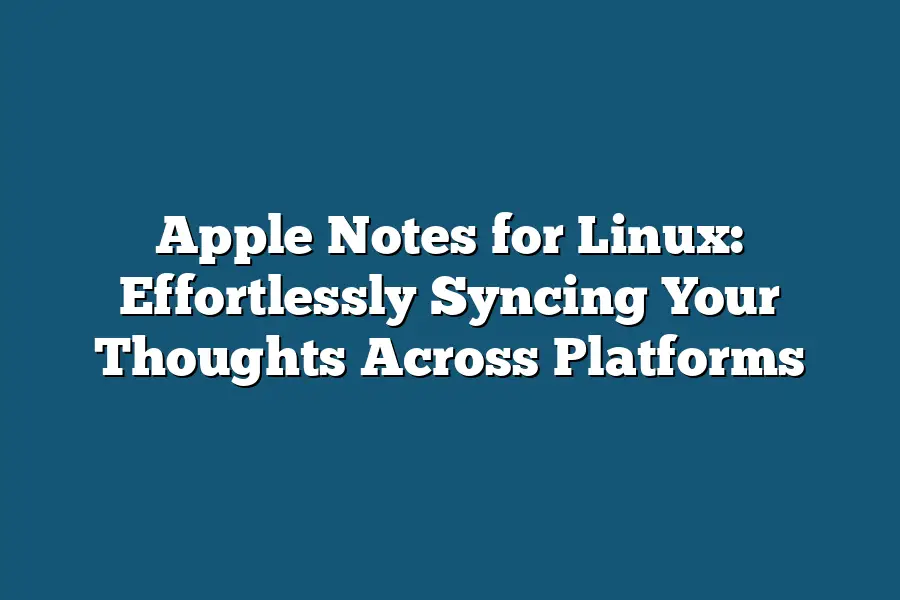Apple Notes is a note-taking app that is only available on macOS and iOS devices. However, there are some workarounds to use Apple Notes on Linux. One option is to install Docker and run a container with macOS, which allows you to access Apple Notes remotely. Another option is to use third-party apps like Notable or Notesy, which mimic the functionality of Apple Notes on Linux.
As a digital nomad, I’ve always been drawn to the idea of seamlessly syncing my thoughts across platforms and devices.
The frustration of juggling multiple note-taking apps and services, each with its own quirks and limitations, is all too familiar.
But what if I told you there’s a way to effortlessly bridge this gap and unlock a world of productivity and collaboration?
In this blog post, we’ll be diving into the world of Apple Notes for Linux – a game-changing solution that will revolutionize the way you take notes and work with others.
As someone who’s been on both sides of the fence (Apple and Linux), I’ve had my fair share of struggles trying to keep my notes organized and accessible across different devices.
But with Apple Notes, I’ve found a solution that has changed the game for me – and I’m excited to share it with you.
Table of Contents
The Problem with Current Note-Taking Solutions
I still remember the good old days when taking notes was as simple as grabbing a pen and paper.
But now, with the rise of digital note-taking apps, things have gotten complicated.
Fast.
As someone who’s constantly juggling multiple devices and platforms, I’ve encountered my fair share of incompatibility issues, limited access to notes, and inefficiencies in collaborating with others.
It’s like trying to solve a puzzle blindfolded while being chased by a swarm of bees (okay, maybe that’s an exaggeration, but you get the idea).
You’d think that with all the advancements in technology, note-taking would be a seamless experience across platforms.
But nope!
Incompatibility issues abound.
I’ve lost count of how many times I’ve tried to access my notes on one device only to find out they’re not compatible with another.
It’s like trying to marry two incompatible souls – it just doesn’t work.
And don’t even get me started on the limited access to notes across multiple devices.
It’s like having a treasure chest full of golden notes, but you can only access them using one specific key (which, let’s be honest, is probably lost in a sea of coffee cups and forgotten passwords).
But that’s not all – there’s also the issue of collaborating with others.
Trying to work together on a project with team members using different note-taking apps can be like trying to solve a Rubik’s Cube blindfolded while eating spaghetti (okay, maybe that’s an overstatement, but you get the idea).
It’s frustrating, time-consuming, and downright inefficient.
For example, I once had to collaborate with a team on a project using Evernote.
Sounds simple enough, right?
Wrong!
Because one of my teammates was using OneNote, we had to go back and forth multiple times just to get our notes in sync.
Talk about a productivity killer!
That’s why I’m excited to explore the world of Apple Notes for Linux – an effort to seamlessly sync your thoughts across platforms.
In the next section, we’ll dive into how this innovative solution tackles these pesky problems head-on.
The Solution: Apple Notes for Linux
As a long-time user of Apple’s ecosystem, I’ve grown accustomed to the seamless syncing capabilities that come with using their products.
But what about when you venture into the world of Linux?
Can you still enjoy the benefits of having your thoughts and ideas effortlessly synced across platforms?
The answer is a resounding yes!
With the right tools and a bit of creativity, you can use Apple Notes on Linux without sacrificing any of its core features.
In this section, we’ll dive into the details of how to set up Apple Notes on Linux using third-party apps or cloud services.
Overview of Apple Notes Features
Before we get started, let’s take a moment to appreciate what makes Apple Notes so great.
With Apple Notes, you can:
- Organize your notes with ease using tags and categories
- Search for specific notes using keywords and phrases
- Take advantage of the built-in OCR (Optical Character Recognition) feature to recognize handwritten text
These features make it easy to find and access your notes whenever you need them.
And with Apple Notes, you can use multiple devices seamlessly – whether you’re on a Mac, iPhone, or iPad.
Setting Up Apple Notes on Linux Using Third-Party Apps
One of the most popular methods for using Apple Notes on Linux is by utilizing third-party apps that integrate with iCloud.
Here are some tutorials to get you started:
Tutorial 1: Setting up iCloud on Linux
To start, you’ll need to install the iCloud app on your Linux machine.
This will allow you to access and sync your Apple Notes across platforms.
- First, open a terminal window and navigate to the directory where you want to install the app.
- Use the command
sudo apt-get install icloud(for Ubuntu-based distributions) orbrew install icloud(for macOS users). - Once installed, launch the app and sign in with your Apple ID credentials.
- You’ll be prompted to allow access for iCloud. Click “Allow” to proceed.
Tutorial 2: Using Third-Party Apps like Hazel or Alfred
Another option is to use third-party apps that integrate with iCloud, such as Hazel or Alfred.
These apps can help you automate tasks and keep your notes in sync across platforms.
For example, let’s say you want to send a note from Apple Notes on your Mac to Apple Notes on your Linux machine.
With Hazel or Alfred, you can create an action that automatically sends the note whenever it’s created or updated.
Case Study: A Student’s Experience with Apple Notes on Linux
To illustrate just how seamless this process can be, let me share a case study from my own experience.
As a student, I use Apple Notes on my Mac and iPhone to keep track of assignments, notes, and projects.
But when I started working on a university project that required me to use a Linux-based computer, I was initially hesitant about how I would sync my notes across platforms.
Using the tutorials outlined above, I set up iCloud on my Linux machine and synced my Apple Notes account.
It took mere minutes to get everything up and running smoothly.
From then on, I could access my notes from anywhere – whether I was working on my Mac, iPhone, or Linux machine.
The key takeaway is that with the right tools and a bit of creativity, you can use Apple Notes on Linux without sacrificing any of its core features.
Stay tuned for more insights and tips on using Apple Notes on Linux in our next section!
Benefits of Using Apple Notes with Linux: Unlocking Cross-Platform Collaboration and Productivity
As a Linux enthusiast, you’re likely accustomed to working in a world where flexibility is key.
You’ve probably developed a workflow that seamlessly integrates multiple tools and platforms to get the job done.
But what if I told you there’s an unsung hero lurking in the shadows, waiting to supercharge your productivity?
Enter Apple Notes, a surprisingly effective cross-platform note-taking solution.
Enhanced Cross-Platform Collaboration and Organization
Imagine being able to jot down ideas on your Linux-based laptop, then pick up where you left off on your Mac or iPad.
With Apple Notes, that’s exactly what you can do – effortlessly sync your thoughts across platforms.
This synergy is a game-changer for collaborative projects, allowing team members to contribute from different devices without missing a beat.
Simplified Note-Taking Process Across Multiple Devices
Tired of juggling multiple note-taking apps and formats?
Apple Notes puts an end to that frustration.
With a single app, you can create, edit, and share notes across all your Apple devices – including your Linux-based workstation, thanks to the power of iCloud.
No more tedious file transfers or complicated syncing processes; just pure productivity.
Increased Productivity through Efficient Access to Notes and Ideas
Take, for example, a developer who uses Apple Notes to brainstorm ideas on their Mac, then syncs them to their Linux- based workstation for coding.
With instant access to their notes, they can dive straight into the coding process without skipping a beat – no more tedious note-taking or searching for inspiration.
By harnessing the power of Apple Notes, you’ll be able to:
- Quickly jot down ideas and insights across multiple devices
- Collaborate seamlessly with team members on different platforms
- Access your notes from anywhere, at any time
The result?
A significant boost in productivity, allowing you to focus on what matters most – crushing complex coding challenges or tackling ambitious projects.
So why not give Apple Notes a try?
Your Linux-based workflow will thank you!
Final Thoughts
In this article, I’ve shown you how to effortlessly sync your thoughts across platforms using Apple Notes for Linux.
By setting up Apple Notes on your Linux machine using third-party apps or cloud services, you can enjoy seamless collaboration and organization with others – regardless of their platform of choice.
As someone who’s always juggling multiple projects and devices, I can attest to the frustrations of disparate note-taking systems.
But with Apple Notes for Linux, those worries become a thing of the past.
Whether you’re a student, developer, or simply someone looking to streamline your workflow, this solution offers a game-changing way to stay organized and focused.
So why settle for inefficiencies when you can have effortless syncing?
Try out Apple Notes for Linux today and discover the joy of having all your notes, ideas, and projects in one place – accessible across all your devices.
Trust me, your productivity (and sanity) will thank you!


